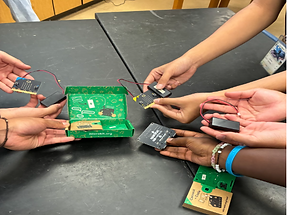
Integrating Computer Science
About
Curriculum resources and professional learning for science teachers to integrate computer science and computational thinking into science instruction. Science researchers regularly use computational thinking to make sense of data and to program instruments. As a core science and engineering practice, visit this page for resources on how to integrate computational thinking and coding into your science instructional practices.



Computer Science Integration Program
The Computer Science Integration Program was a 2 year funded effort to support teachers with exploring how to integrate computer science into science instructional units that used climate and/or environmental based anchoring phenomena. Click below to access each resource and a blog post that tells the story of implementation.
Micro:bit Launch Activities - All grades
Use these short lessons to introduce micro:bits to your students. You can use these lessons for introduce, review, or re-engage students with programming micro:bits.
Blog Post about the Lesson (Coming Soon)

Cooler Communities - Grades 5, 6, 7
For Grades 5, 6, or 7, use micro:bits to design a code to measure and collect temperature data from different areas around campus. Then, use your data to design a solution that would help create cooler communities.
Blog Post about using Micro:bits to Cool Communities

Bringing Science to Life: Student Voices, Data, and Pollinator Action
When middle school students step into the role of scientists, powerful learning happens. Two Californian teachers, Caitlyn Day and Rachel Davey, explain their experience teaching the Micro:bit unit that combined hands-on data collection, student voice, and local action. With tools like Microbits, partnerships with community organizations, and a call to action at the heart of the project, students not only learned about biodiversity—they became part of the solution.
Blog Post about using Micro:bits to suppor pollinators
Storyline with links to curriculum and resources

High School Cooler Communities: Leveraging Micro:bits for Science Learning
For High School Science, use micro:bits to design a code to measure and collect temperature data from different areas around campus. Then, use your data to design a solution that would help create cooler communities.
Blog Post about using Micro:bits to Cool Communities
-
All links to the curriculum resources are at the end of the blog post.

Incorporating Micro:bits to Conductivity Data Collection
Students program micro:bits to investigate why certain materials conduct electricity while others do not. Students will then use this information to make a prediction as to which materials should be used when building a working circuit.
Blog Post about using Micro:bits for Conductivity Explorations
-
All links to the curriculum resources are at the end of the blog post.
Lesson Outline with background information, daily slides, handouts, and answer keys

Rocket Science Made Real: How Micro:bits Brought My Water Rocket Lab to Life
A fun upgrade to the classic water rocket lab that use Micro:bits with their built-in accelerometers to collect real-time acceleration data during the rocket launch
Blog Post about using Micro:bits to study Rocket Acceleration
-
All links to the curriculum resources are at the end of the blog post.


.png)